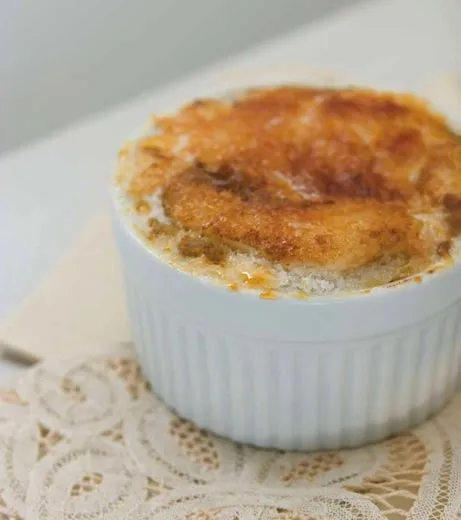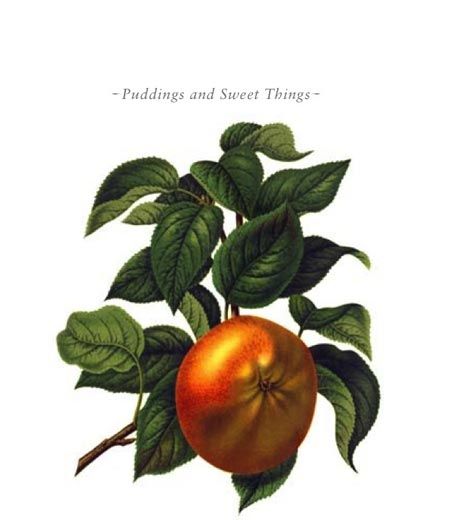At Home with the Darwins
Recipes offer an intimate glimpse into the life of Charles Darwin and his family
/https://tf-cmsv2-smithsonianmag-media.s3.amazonaws.com/filer/Darwin-recipe-nesselrode-pudding-631.jpg)
In 1839, two years after he had returned from his epochal voyage aboard the Beagle, Charles Darwin married his cousin Emma Wedgwood. (The two were grandchildren of Josiah Wedgwood, founder of the renowned British pottery.) It was to be a love match of the highest order: the Darwins, who would have ten children, lived in harmony for more than 40 years, until Charles’ death in 1882. Darwin was devoted to his spirited, intelligent wife, whom he described as “good as twice refined gold.”
The Darwins presided over a lively household in a rambling country manse, Down House, in Kent, 16 miles from London. There, Darwin worked in his study, laboring over On the Origin of Species and delighting in family life. In their inventive take on the life of the Darwin family, writers Dusha Bateson and Weslie Janeway, authors of Mrs. Charles Darwin’s Recipe Book, Revived and Illustrated, record an intimate glimpse into the everyday lives of this most eminent of Victorian clans. Bateson and Janeway’s vehicle is a slim little volume, a mere eight by four inches, bound in leather and fitted with marble endpapers.
Emma Darwin’s recipe book recorded some of the dishes—cheese souffle to mutton ragout and gooseberry cream—enjoyed by the family as they gathered in the dining room at Down House.
As Bateson and Janeway tested and re-created Emma’s dishes for a full-color survey of Emma’s original recipes, they also engaged in a particular take on time travel. Their historical and culinary detective work affords a unique and intimate glimpse of the Darwins. It is as if we are at table with the family, passing the Nesselrode pudding before pushing back our chairs and dispersing for a game of whist or a stroll in the orchard.
For cooks and historians, Victoriana buffs and anyone interested in an unexpected journey— an excursion into the world of Charles Darwin and his family— the authors offer an original and vivid window on a vanished world of 19th-century Britain.
“Above all,” write Bateson and Janeway, “cooking and eating a dish enjoyed by Charles Darwin and his family brought us closer to the great man.” As for Emma herself, they add, “We felt a growing admiration and warmth, and found it was natural to refer to her by her first name.”
A selection of recipes follows:
BURNT CREAM
Burnt cream, or crème brulée as it is now more commonly known, is a famous English pudding and certainly one of the best. The contrast between the cool, rich custard and the crisp, glassy layer of caramelized sugar is truly delicious. In fact, it is a simple dish of cream, egg yolks, and sugar but made in surprisingly different ways. What is generally agreed upon is that you boil the cream and then pour it onto well-beaten egg yolks, stirring as the mixture cools. After that, opinions differ; some continue to cook the custard until it “coats the back of the spoon.” Others bake it in a low oven. Still others simply let the mixture cool completely, then chill it before adding the final layer of sugar on the top.
In Elizabeth Raffald’s The Experienced English Housekeeper (1769), you find the recipe closest to the one given by Emma. This, interestingly, includes whole eggs and flour. No mention is made of any flavoring—orange-flower water would have been popular in the eighteenth century, vanilla would be the obvious choice today. Then, looking more closely at Emma’s original ingredients and quantities, more questions arise. One tablespoonful of flour to only one cup of cream will surely result in an unacceptably thick mixture. And to what extent should the egg whites be whipped? As though you’re making meringue? A trial run with less flour, about half, and whites whipped to the “soft peak” stage, and then carefully folded into the cream/egg-yolk mixture, produced custard that tasted fine but remained rather runny and by the following day had become considerably more so. Any topping was doomed to sink. A second attempt, using the full tablespoonful of flour, was much more successful. You do have to boil the cream and flour gently for about ten minutes to make sure the flour is properly cooked, otherwise it will taste raw. Serves four.
Burnt Cream, with its rich custard base and crunchy topping, this dessert is nothing short of perfection.
1 tablespoon flour
1 cup (250 ml) heavy cream
2 eggs, separated
2 ounces (60 g) superfine (castes) sugar, plus 1 teaspoon
1. Mix the flour in a medium saucepan with a little milk or water before adding it to the cream; this will prevent lumps. Bring to a boil and cook gently for about 10 minutes to ensure the flour is thoroughly cooked.
2. Add the egg yolks and 1 teaspoon of sugar. (You can do without the sugar at this stage if you like, as the caramelized top will provide plenty in the finished dish.)
3. Beat the egg whites only until they form a frothy liquid and add them to the pan.
4. Taste and, if you are satisfied that no hint of a floury taste remains, pour the mixture into an ovenproof dish and allow to cool.
Chill overnight.
The Result: A well-set custard with no hint of flour and possibly a lighter texture than one made only with cream and yolks. All that remains is to “salamander” it. The salamander, an iron disc with a long handle, must have been a fearsome instrument when in use. The disc is heated redhot, then passed to-and-fro over and close to the dish.
Fortunately, today, there are other solutions, the most recent being the culinary blowtorch. Simply sprinkle an even layer of superfine (castes) sugar over the custard and direct the flame over the surface until the desired effect is obtained. Lacking one of these gadgets, the usual instruction is to place the dish, complete with its sugar, under a grill preheated to its maximum temperature. An even, glassy smoothness will result. It is not as easy at it sounds. It takes a long time for the sugar to melt—while you worry that the dish, if it is not metal, will crack or the custard begin to bubble. Then there is the problem of evenness as the sugar develops “hot spots,” where it starts to burn locally and you have to turn the dish about. All this quite possibly while you are on your knees, if your grill is not at eye level! Far simpler is to put the superfine (castes) sugar in a small heavy saucepan and heat it gently until it melts. Do not stir. When it starts to color and bubble, tip the pan in a circular motion so the sugar is well mixed and dissolves completely. Watch it carefully—it can burn very quickly. What you want is a deep auburn color with that wonderful caramel smell. Then, holding the custard dish in one hand, pour the molten sugar onto the top, tipping the dish so it covers evenly. The sugar will bubble up, but do not worry, it will soon subside. With this method, a beautiful thin layer is achieved. Do this a couple of hours before you want to eat. As soon as the sugar has cooled, chill until needed.
BAKED APPLE PUDDING
The most famous batter pudding is Yorkshire pudding, traditionally served with roast beef. Jane Grigson tells of her grandfather’s family, where the Yorkshire pudding, having done its duty by the beef, was then finished up with sweetened condensed milk! The Victorians had many recipes for sweet puddings with batter, so there is nothing particularly strange about this dish. Today, apples are usually baked without peeling them—the skins help them to keep their shape, so you finish up with apples still looking like apples, but beautifully soft and fluffy inside. With this dish, where the apples are peeled, they collapse on cooking and the juices and flavor spread into the surrounding batter—very nice, too. Use well-flavored baking apples and serve with a sprinkling of sugar and plenty of cream. Serves four to six.
6 apples
2 tablespoons sugar, plus more for sprinkling
½ teaspoon finely grated lemon peel
1 tablespoon butter
For the batter:
3 ounces (90 g) flour
1 cup (250 ml) milk
2 eggs
In Preparation: Grease an ovenproof dish deep enough to hold the apples and batter. Preheat oven to 350°F (180°C).
1. Peel and core the apples. Place them in the prepared dish. In each hole, put a teaspoon of sugar, a little grated lemon peel, and top with a small piece of butter. Bake for 20 minutes. Remove the apples from the oven and raise the temperature to 400°F (200°C).
2. While the apples are baking, sift the flour into a bowl and make a well in the center. Add the milk, a little at a time, and mix to a smooth batter. Beat in the eggs, one at a time.
3. Pour the batter over the apples and bake for about 30 minutes, or until well risen and brown on top. Sprinkle with sugar and serve at once with cream.
NESSELRODE PUDDING
If charts for puddings existed as they do for popular songs, then Black Forest Gateau, Baked Alaska, and Tiramisu would have topped them at different times. Nesselrode Pudding must have been similarly fashionable for several decades in the 19th century. Nesselrode himself was a Russian statesman active during the Napoleonic wars, present at the Congress of Vienna (1814-1815), and a signatory, in 1856, of the Paris peace agreement after the Crimean War. He was a great survivor. In the course of his long career, he had many dealings with that other wily statesman, Talleyrand.
For a time, the great French chef Antonin Carème worked for Talleyrand and indeed went with him to Vienna in 1814. Perhaps it was there that he created the pudding and paid Nesselrode the compliment of naming it after him. Both Eliza Acton and Mrs. Beeton give a recipe for Nesselrode Pudding in their books and both attribute it to Carème, though neither admits to having made it. Obviously his name gave the recipe a certain cachet. Carème, also chef for a time to the prince regent, was famous for his elaborate and ambitious creations, and, indeed, the pudding described by the English ladies is very demanding. Sweetened and puréed chestnuts, a rich custard, fruit soaked in maraschino, an Italian meringue mixture, all frozen and molded into exotic shapes at different times, meant this pudding was not for the inexperienced or single-handed cook. Fortunately, for present purposes, Emma’s version is a much simplified one. A small quantity of ground almonds is substituted for “forty best Spanish chestnuts” and twelve egg yolks become six. What we have here is a rich ice cream with dried fruit and a glass of brandy to make it special.
Serves six to eight.
8 ounces (240 g) dried fruit, finely chopped
¾ cup (175 ml) brandy, Maraschino, or any fruit liqueur
½ vanilla bean
2 cups (500 ml) heavy cream
1 cup (250 ml) milk
6 egg yolks
2 ounces (60 g) sugar
1 ounce (30 g) ground almonds
1. If the dried fruit includes glacé cherries, large raisins, or other large fruits, chop them into smaller pieces. Pour the brandy over them and leave to soak overnight.
2. Split open the vanilla bean lengthwise and scrape out the tiny seeds into the cream along with the outer bean. Bring cream and milk to a boil in a saucepan.
3. In a medium bowl, beat egg yolks with the sugar. When nice and creamy, beat in the ground almonds.
4. Discard the vanilla bean pieces and pour the hot cream and milk onto the egg yolk mixture, beating constantly.
5. Transfer the custard to a double boiler and, stirring constantly, cook over a medium heat until the custard thickens. Have patience, it may take 10 minutes or more and it is important not to let it boil.
6. Remove it from the heat, add the brandy and fruit, and stir well. Let the custard to cool. Refrigerate.
7. When thoroughly chilled, pour the mixture into an ice cream machine and freeze according to the manufacturer’s instructions. If you do not have a machine, put the mixture into a suitable container and freeze for a couple of hours. When the ice cream begins to harden around the edges, give it a good stir and freeze again. For a really creamy consistency, you may need to repeat this.
8. Soften the ice cream slightly in a refrigerator for some time before serving.


